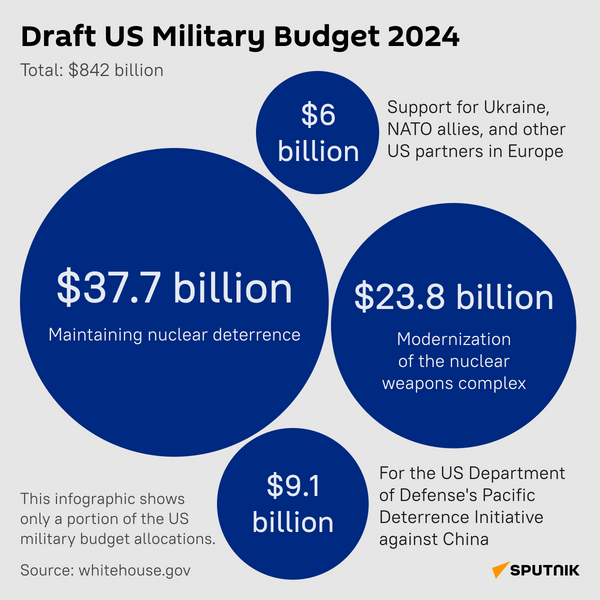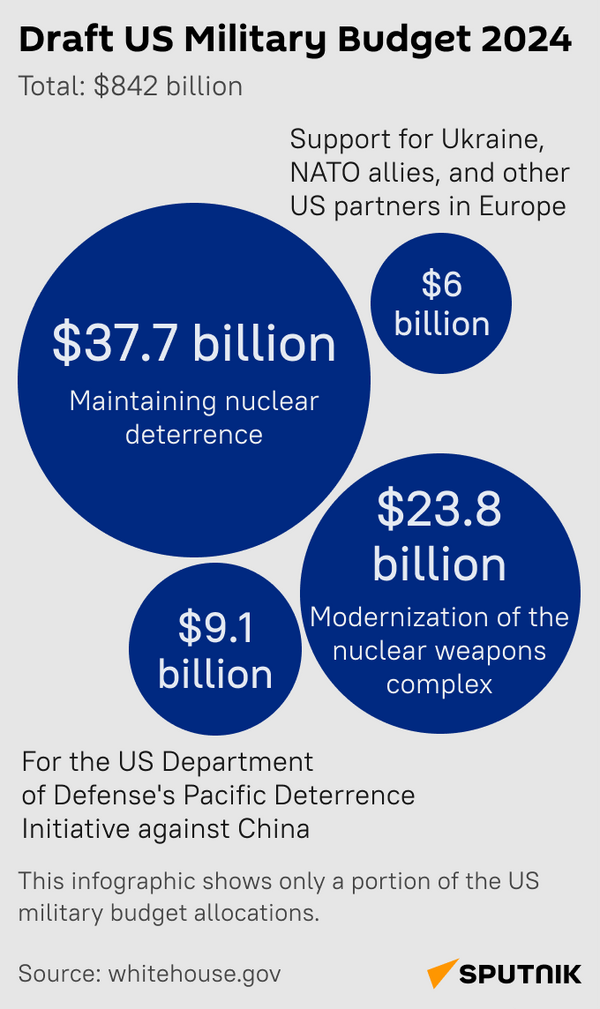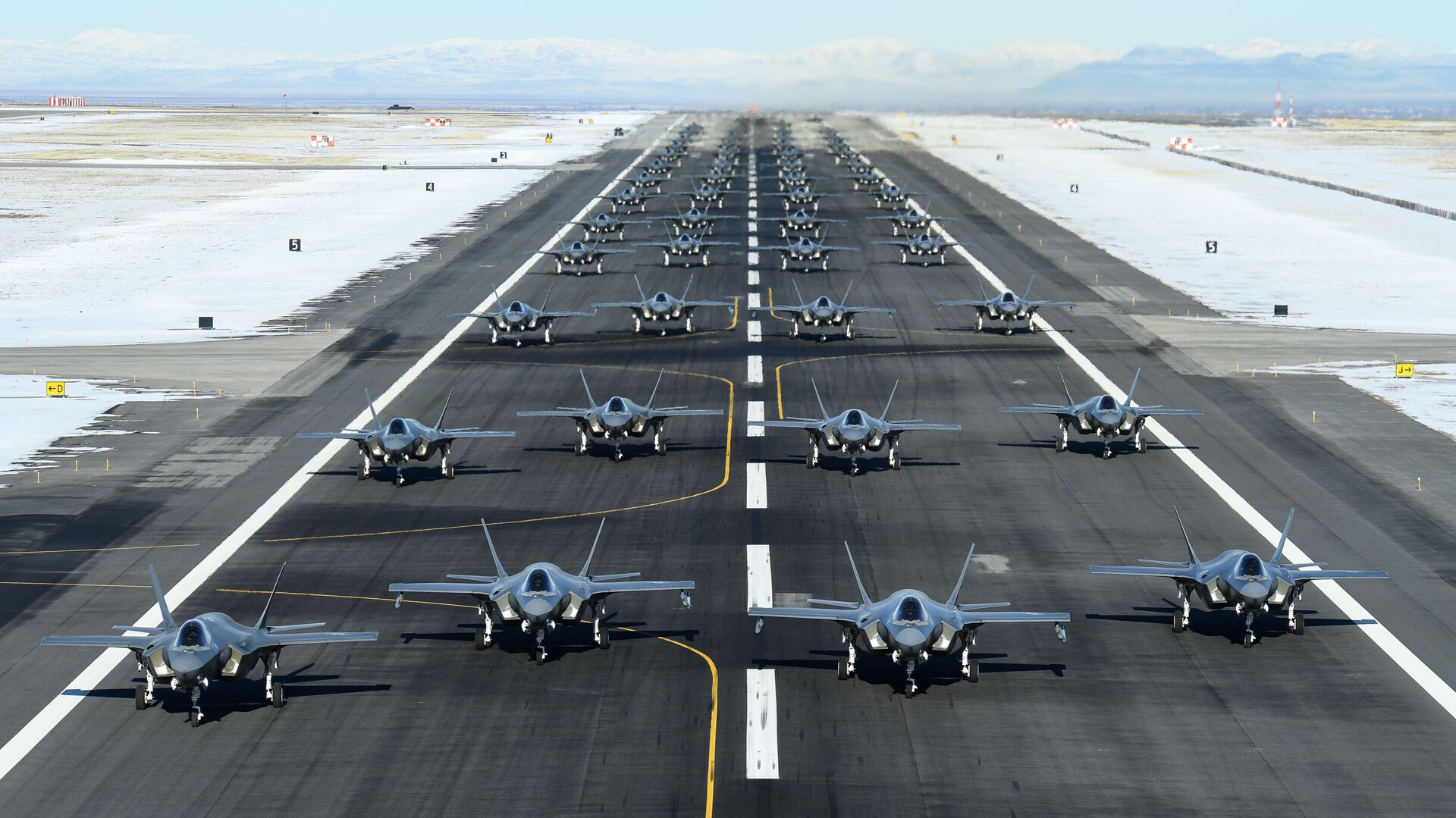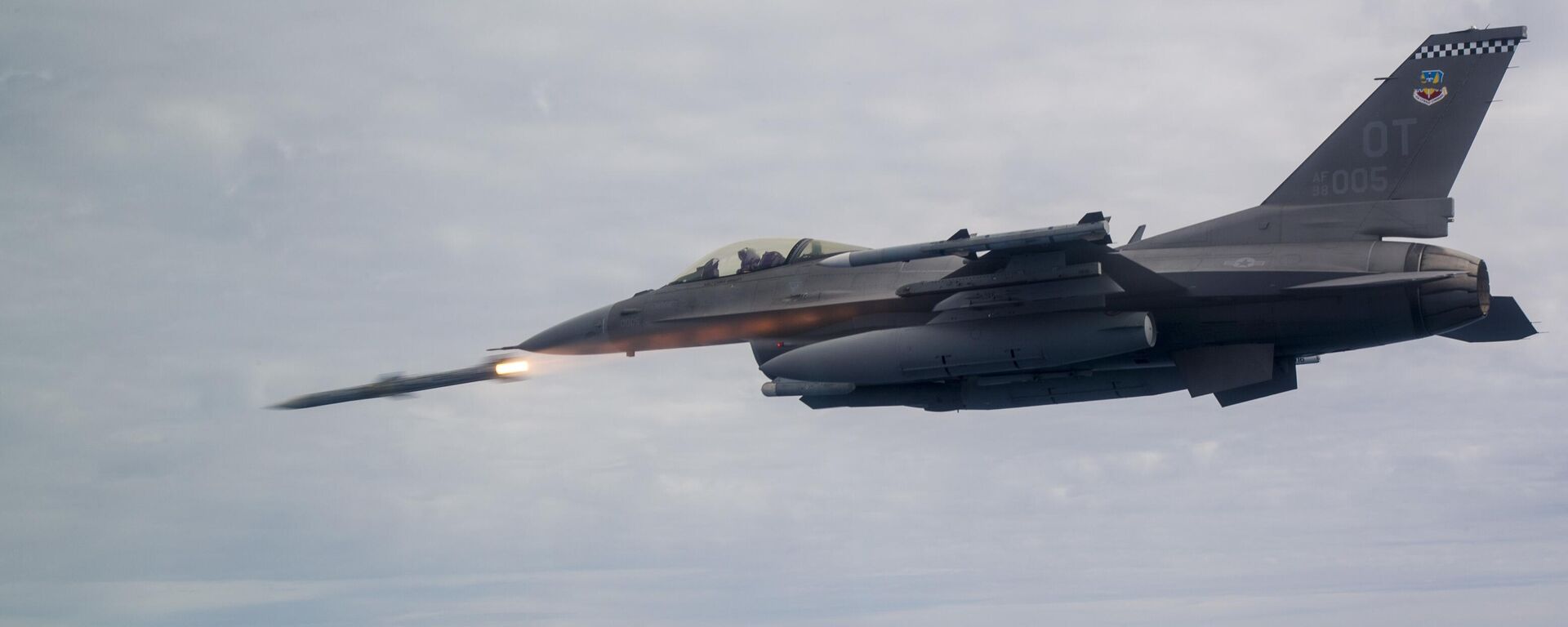https://sputnikglobe.com/20230310/why-bloated-us-military-spending-cant-ensure-its-dominance-over-russia-china-1108266963.html
Why Bloated US Military Spending Can't Ensure Its Dominance Over Russia, China
Why Bloated US Military Spending Can't Ensure Its Dominance Over Russia, China
Sputnik International
The White House has requested a whopping $842 billion for the Pentagon for fiscal year 2024, which is $69 billion more than the Department of Defense received for FY2023. What's behind the hike and does it truly correspond with the US' national security interests?
2023-03-10T16:43+0000
2023-03-10T16:43+0000
2023-04-13T12:45+0000
analysis
us
opinion
military & intelligence
joe biden
f-35
military spending
us defense spending
spending
house gop
https://cdn1.img.sputnikglobe.com/img/107796/92/1077969241_0:0:3641:2048_1920x0_80_0_0_f60094448f8b87b6d530e409433f8b6d.jpg
"The new US defense budget of $840 billion for the coming year, an increase of 3.2% over the last, includes two major figures," retired Major General Harsha Kakar, strategic analyst and founding member of the think tank STRIVE, told Sputnik. "One is $9.1 billion for basically the Indo-Pacific region. The other - for updating its nuclear arsenal, for which it has earmarked $37 billion or $38 billion. And, of course, $6 billion [is allocated] for assistance to Ukraine."On March 9, the Biden administration unveiled its budgetary roadmap, with Secretary of Defense Lloyd Austin lauding the White House's move as enabling the Department of Defense "to continue building a Joint Force that is the most lethal, resilient, survivable, agile, and responsive in the world and is guided by our three priorities of defending the nation, taking care of our people, and succeeding through teamwork."However, US observers immediately drew attention to the gargantuan size of the Pentagon's new budget. While the DoD's request amounts to $842 billion, the White House is requesting $886.4 billion in funding for national security. But that is not all, DC think tanks warn: if one adds emergency military aid packages for Ukraine this year and potential tens of billions of dollars in Congressional "add-ons" the total defense spending is about to reach a staggering $950 billion or more for FY2024. The Quincy Institute for Responsible Statecraft, a US think tank, has called the forthcoming Pentagon budget the "biggest since World War II," and far bigger than at the peaks of the Korean, Vietnam, or Cold Wars.The DoD's expenditures have been steadily growing over the past few years, adding $25 billion in 2022, $45 billion in 2023, and potentially $69 billion in 2024.The vast geography of Washington's defense plans could be explained by its belief that apart from protecting itself and its allies it should also ensure its military dominance in the respective regions, the Indian expert noted. Since the US sees a number of countries as its competitors, it seeks to suppress them militarily, according to Kakar. "So therefore, it is going to continue expanding far more than what is required," he noted.Big Spending Doesn't Always Mean Good QualityStill, the Pentagon's bloated spending does not always mean that the US military gets the highest quality for their money, according to Sputnik's interlocutors."At the same time, these are military developments that have been carried out as scientific research programs, the delivery of new types of weapons, and they often lag behind all the scientific and technological progress that has been developed, for example, in Russia, in China, and even in Iran and North Korea. Getting carried away with some innovative programs, the US, or rather the military budget, does not take into account the current cost of keeping the American Army 100% combat ready," he continued.According to some estimates, more than half of the new DoD budget will go to major defense contractors, including Lockheed Martin, Boeing, Raytheon, General Dynamics, and Northrop Grumman, on buying, researching, and developing weapons. However, the observers refer to an embarrassing record of overspending and alleged mismanagement of funds when it comes to the US military-industrial complex.One glaring example is the F-35 fighter that has already become the costliest weapon system in American history. The F-35's estimated sustainment costs over its 66-year anticipated life cycle have steadily increased since 2012, from $1.11 trillion to $1.27 trillion, despite purported efforts to reduce costs. Although the project was launched over 20 years ago and 800 airplanes have already been delivered, the stealth fighter jet's production has been "marred by excessive defects and rework" that have reduced US military readiness, as per the US press.Military Lobbyists and Apparent CorruptionLeonkov noted that the US lobby culture plays a big role in the distribution of military funds, while Joe Biden and his administration are accepting this state of affairs and even playing into the lobbyists' hands."Lobbyist structures create such a paradox that despite the fact that the US military budget is the largest in the world and unprecedented for the United States itself, its effectiveness is much lower than the military budgets of Russia and China, the DPRK and Iran," Leonkov said.For instance, the US military industrial complex has yet to come up with competitive domestically-made hypersonic weapons, lagging behind both Russia and China.And still, the US has yet to achieve the speeds that Russia's hypersonic complexes have already achieved, Leonkov remarked. Meanwhile, Russia and China are not sitting on their thumbs and have already been working on the next generation of hypersonic weapons. Even heavily embargoed North Korea is claiming that it, too, has received this complex of weapons."So despite all the power of the US military-industrial complex, despite the enormous money they spend on its upkeep and development, they cannot make the technological breakthrough that Russia, China, and North Korea have been following and have achieved their results," said the Russian analyst.Afghanistan and Mideast Campaigns: Where Did the Money Go?Likewise, it's hardly surprising that the US military has complained about the depletion of their ammunition stockpiles as Washington is flooding Ukraine with weapons and shells. Leonkov cites American experts as saying that it would take 15 years to replenish the amount of ammunition that has been delivered to Ukraine from US military warehouses."This indicates that the production of the military-industrial complex itself is not yet expanding," the military expert stressed.Washington's earlier campaigns have also been marred with scandals surrounding an apparent misappropriation of funds and excessive spending.Indeed, the Taliban* ended up winning in Afghanistan, while the Americans had to flee the country, leaving behind, among other things, huge stockpiles of military equipment and their puppet government, Rozhin noted. As for Iraq, in the wake of the US invasion, Iran has dramatically increased its position in the Middle Eastern country, something that runs contrary to Washington's interests.To cap it off, while the Pentagon's total spending in the Middle East and Afghanistan is estimated at about $7.5 trillion, it was possible to find confirmation of the spending of about $5 trillion, while $2.5 trillion vanished into thin air, Leonkov remarked.Why Biden Will Have Hard Time Getting New Pentagon Budget Through CongressThe Pentagon's gargantuan military request has already been met with criticism from Joe Biden's own party. Representatives Barbara Lee (D-Calif.) and Mark Pocan (D-Wis.) have brought forward the “People Over Pentagon Act,” which proposes a $100 billion annual cut in the Pentagon budget.“Year after year, this country pours billions into our already-astronomical defense budget without stopping to question whether the additional funding is actually making us safer. We know that a large portion of these taxpayer dollars are used to pad the pockets of the military industrial complex, fund outdated technology, or are simply mismanaged,” Barbara Lee said in a statement on February 22.The Democrats' concerns are by no means surprising, given that increased defense spending "would be one area that Biden would seem to run counter to general Democratic preferences," according to Timothy Hagle, a political science professor at the University of Iowa.At the same time, however, Hagle pointed out that Biden's overall budget, which envisions trillions of dollars in new spending, is likely to trigger criticism from US lawmakers, especially given that its promise to reduce deficits by raising taxes on businesses and the wealthy does not look realistic."The national debt continues to grow and the tax increases he proposes are not likely to even cover his desired new spending," the political science professor underscored. "Part of the problem is that tax increases along the lines proposed by Biden generally do not work out. Corporations can pass the taxes on to their consumers and the rich (however you define them) can usually move their assets around to limit their tax liability. Thus, it ends up that the middle class have to pick up the tab for the increase in spending, either directly by having their own taxes increased, or indirectly by higher prices on goods and services or lower returns on their investments."Given all of the above, Hagle expects that Biden "will have a hard time getting such a proposal through the US Congress, especially the House, which is controlled by Republicans."Even though the increase in defense spending might be a way to entice some House Republicans to go for it, Hagle is not sure that it will work.*The Taliban is under UN sanctions over terrorist activities.
https://sputnikglobe.com/20230309/obama-era-pentagon-chief-who-helped-destroy-libya-wants-fighter-jets-for-ukraine-1108209958.html
https://sputnikglobe.com/20230222/us-navy-blames-rookie-pilot-for-disastrous-f-35-crash-that-saw-jet-plummet-into-south-china-sea-1107684556.html
https://sputnikglobe.com/20230305/large-amount-of-purported-us-military-hardware-spotted-at-polish-port-video-1108070068.html
https://sputnikglobe.com/20221121/us-seeks-to-catch-up-to-russia-china-in-hypersonic-weapons-development-1104514390.html
https://sputnikglobe.com/20230120/russian-presidents-envoy-for-afghanistan-says-there-is-evidence-us-secretly-sponsoring-daesh-1106520915.html
afghanistan
iraq
ukraine
Sputnik International
feedback@sputniknews.com
+74956456601
MIA „Rossiya Segodnya“
2023
News
en_EN
Sputnik International
feedback@sputniknews.com
+74956456601
MIA „Rossiya Segodnya“
Sputnik International
feedback@sputniknews.com
+74956456601
MIA „Rossiya Segodnya“
us military spending, pentagon budget, biden's defense budget for fy2024, biggest us military budget, f-35 program's controversies, ineffective military spending, military lobbyists, joe biden's 2024 budget, house republicans,
us military spending, pentagon budget, biden's defense budget for fy2024, biggest us military budget, f-35 program's controversies, ineffective military spending, military lobbyists, joe biden's 2024 budget, house republicans,
"The new US defense budget of $840 billion for the coming year, an increase of 3.2% over the last, includes two major figures," retired Major General Harsha Kakar, strategic analyst and founding member of the think tank STRIVE, told Sputnik. "One is $9.1 billion for basically the Indo-Pacific region. The other - for updating its nuclear arsenal, for which it has earmarked $37 billion or $38 billion. And, of course, $6 billion [is allocated] for assistance to Ukraine."
"Now, when you look at this figure, an increase of $9 billion, basically for increasing its capability in the Indo-Pacific, will possibly just about strengthen the US presence in the region. It's not going to shift any major balance of power, unless its allies, mainly in the Quad, contribute in a similar manner to the effect that the US is putting in, in terms of spending for that region," the Indian expert continued.
On March 9, the Biden administration unveiled its budgetary roadmap, with Secretary of Defense Lloyd Austin lauding the White House's move as enabling the Department of Defense "to continue building a Joint Force that is the most lethal, resilient, survivable, agile, and responsive in the world and is guided by our three priorities of defending the nation, taking care of our people, and succeeding through teamwork."
However, US observers immediately drew attention to the gargantuan size of the Pentagon's new budget. While the DoD's request amounts to $842 billion, the White House is requesting $886.4 billion in funding for national security. But that is not all, DC think tanks warn: if one adds emergency military aid packages for Ukraine this year and potential tens of billions of dollars in Congressional "add-ons" the total defense spending is about to reach a staggering $950 billion or more for FY2024. The Quincy Institute for Responsible Statecraft, a US think tank, has called the forthcoming Pentagon budget the "biggest since World War II," and far bigger than at the peaks of the Korean, Vietnam, or Cold Wars.
The DoD's expenditures have been steadily growing over the past few years, adding $25 billion in 2022, $45 billion in 2023, and potentially $69 billion in 2024.
"I think they will reach a consensus on the issue of increasing the defense budget," Boris Rozhin, a Russian expert at the Center for Military-Political Journalism, told Sputnik. "So, some of the money will go to expanding the US military presence in Eastern Europe and supporting their satellites in Europe. Much of the money will go to strengthening the US position in the Far East - in the Asia-Pacific region, where they are now pumping weapons into Taiwan, and preparing for further escalation of relations with China. Therefore, these expenditures will be directed to the state strategy, where Russia and China are designated as enemies of the United States. Accordingly, the bulk of the new spending will be directed precisely against Russia and China."
The vast geography of Washington's defense plans could be explained by its belief that apart from protecting itself and its allies it should also ensure its military dominance in the respective regions, the Indian expert noted. Since the US sees a number of countries as its competitors, it seeks to suppress them militarily, according to Kakar. "So therefore, it is going to continue expanding far more than what is required," he noted.
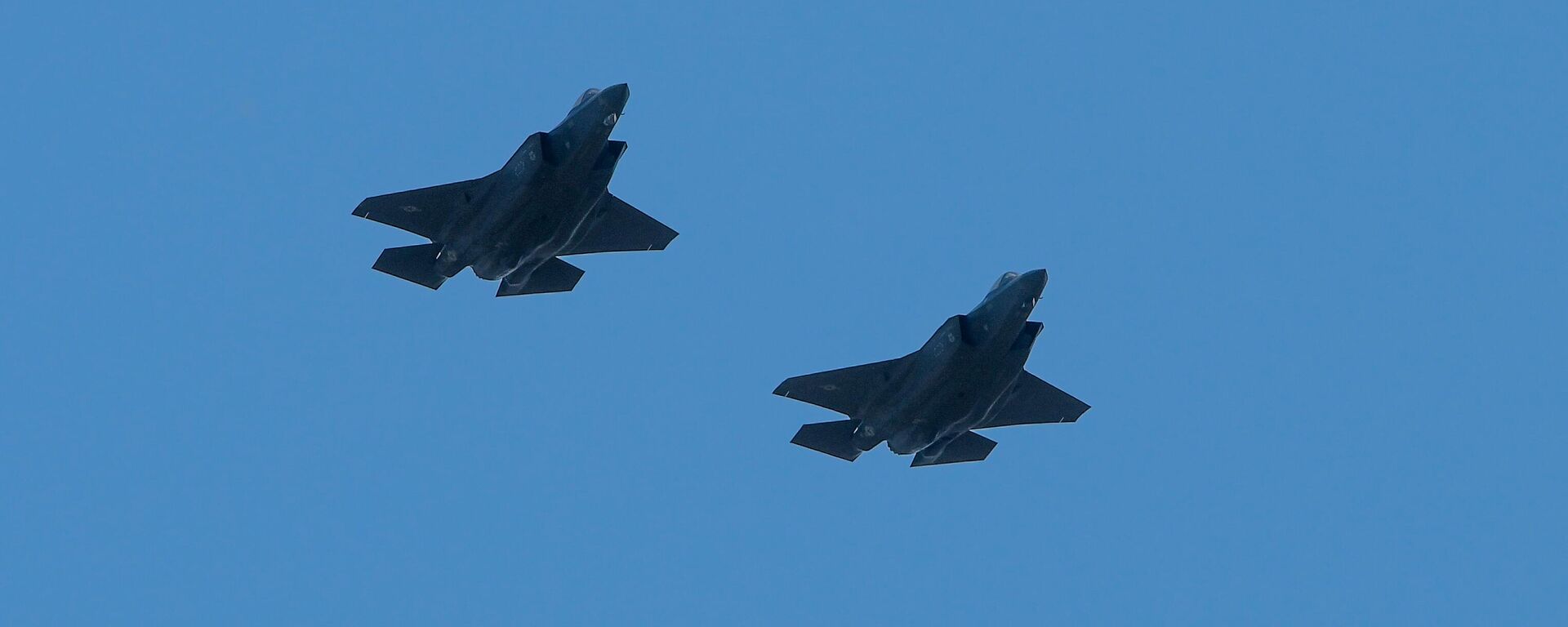
22 February 2023, 04:15 GMT
Big Spending Doesn't Always Mean Good Quality
Still, the Pentagon's bloated spending does not always mean that the US military gets the highest quality for their money, according to Sputnik's interlocutors.
"Addressing the egregious issues present in the US Air Force, the US Navy, and the US Strategic Nuclear Forces, the so-called nuclear doctrine, there are no such big developments because the United States, having the largest number of military bases and being involved in various conflicts, has actually, let's say, brought its weapons fleet to a state close to satisfactory. Although in fact, some estimate a much more radical, worse state," said Alexey Leonkov, military expert and an editor at the magazine Arsenal Otechestva.
"At the same time, these are military developments that have been carried out as scientific research programs, the delivery of new types of weapons, and they often lag behind all the scientific and technological progress that has been developed, for example, in Russia, in China, and even in Iran and North Korea. Getting carried away with some innovative programs, the US, or rather the military budget, does not take into account the current cost of keeping the American Army 100% combat ready," he continued.
According to some estimates, more than half of the new DoD budget will go to major defense contractors, including Lockheed Martin, Boeing, Raytheon, General Dynamics, and Northrop Grumman, on buying, researching, and developing weapons. However, the observers refer to an embarrassing record of overspending and alleged mismanagement of funds when it comes to the US military-industrial complex.
One glaring example is the F-35 fighter that has already become
the costliest weapon system in American history.
The F-35's estimated sustainment costs over its 66-year anticipated life cycle have steadily increased since 2012, from $1.11 trillion to $1.27 trillion, despite purported efforts to reduce costs. Although the project was launched over 20 years ago and 800 airplanes have already been delivered, the stealth fighter jet's production has been "marred by excessive defects and rework" that have reduced US military readiness, as per the US press.
Military Lobbyists and Apparent Corruption
Leonkov noted that the US lobby culture plays a big role in the distribution of military funds, while Joe Biden and his administration are accepting this state of affairs and even playing into the lobbyists' hands.
"Lobbyist structures create such a paradox that despite the fact that the US military budget is the largest in the world and unprecedented for the United States itself, its effectiveness is much lower than the military budgets of Russia and China, the DPRK and Iran," Leonkov said.
For instance, the US military industrial complex has yet to come up with competitive domestically-made hypersonic weapons, lagging behind both Russia and China.
"Although Americans are spending staggering or fantastic amounts of money to develop [hypersonic] technology, they are not up to the task on their own," the Russian military expert continued. "So they have brought in hypersonic specialists from Europe, Japan, and Australia to work on this problem. And now they are trying to work together to create an appropriate flight model, which should be completed somewhere around 2025."
And still, the US has yet to achieve the speeds that Russia's hypersonic complexes have already achieved, Leonkov remarked. Meanwhile, Russia and China are not sitting on their thumbs and have already been working on the next generation of hypersonic weapons. Even heavily embargoed North Korea is claiming that it, too, has received this complex of weapons.
"So despite all the power of the US military-industrial complex, despite the enormous money they spend on its upkeep and development, they cannot make the technological breakthrough that Russia, China, and North Korea have been following and have achieved their results," said the Russian analyst.

21 November 2022, 18:51 GMT
Afghanistan and Mideast Campaigns: Where Did the Money Go?
Likewise, it's hardly surprising that the US military has complained about the depletion of their ammunition stockpiles as Washington is flooding Ukraine with weapons and shells. Leonkov cites American experts as saying that it would take 15 years to replenish the amount of ammunition that has been delivered to Ukraine from US military warehouses.
"This indicates that the production of the military-industrial complex itself is not yet expanding," the military expert stressed.
Washington's earlier campaigns have also been marred with scandals surrounding an apparent misappropriation of funds and excessive spending.
"Over $2 trillion has been spent in Afghanistan," said Rozhin. "I mean, an enormous amount of money was spent in Iraq, where the United States ended up achieving somewhat different goals than it had set out to achieve."
Indeed, the Taliban* ended up winning in Afghanistan, while the Americans had to flee the country, leaving behind, among other things, huge stockpiles of military equipment and their puppet government, Rozhin noted. As for Iraq, in the wake of the US invasion, Iran has dramatically increased its position in the Middle Eastern country, something that runs contrary to Washington's interests.
To cap it off, while the Pentagon's total spending in the Middle East and Afghanistan is estimated at about $7.5 trillion, it was possible to find confirmation of the spending of about $5 trillion, while $2.5 trillion vanished into thin air, Leonkov remarked.

20 January 2023, 09:32 GMT
Why Biden Will Have Hard Time Getting New Pentagon Budget Through Congress
The Pentagon's gargantuan military request has already been met with criticism from Joe Biden's own party. Representatives Barbara Lee (D-Calif.) and Mark Pocan (D-Wis.) have brought forward the “People Over Pentagon Act,” which proposes a $100 billion annual cut in the Pentagon budget.
“Year after year, this country pours billions into our already-astronomical defense budget without stopping to question whether the additional funding is actually making us safer. We know that a large portion of these taxpayer dollars are used to pad the pockets of the military industrial complex, fund outdated technology, or are simply mismanaged,” Barbara Lee said in a statement on February 22.
The Democrats' concerns are by no means surprising, given that increased defense spending "would be one area that Biden would seem to run counter to general Democratic preferences," according to Timothy Hagle, a political science professor at the University of Iowa.
"Republicans are generally in favor of defense spending, though the amounts may be at issue," Hagle told Sputnik. "The current situation with US spending to support Ukraine almost reverses that. Democrats seem willing to spend more to support Ukraine and Republicans more on the skeptical side. If the additional defense spending is just to compensate for the money spent to support Ukraine, then Republicans may be skeptical of it. If the money is being spent on projects that are needed, such as upgrading various defense systems, then Republicans would likely be more in favor of it."
At the same time, however, Hagle pointed out that Biden's overall budget, which envisions trillions of dollars in new spending, is likely to trigger criticism from US lawmakers, especially given that its promise to reduce deficits by raising taxes on businesses and the wealthy does not look realistic.
"The national debt continues to grow and the tax increases he proposes are not likely to even cover his desired new spending," the political science professor underscored. "Part of the problem is that tax increases along the lines proposed by Biden generally do not work out. Corporations can pass the taxes on to their consumers and the rich (however you define them) can usually move their assets around to limit their tax liability. Thus, it ends up that the middle class have to pick up the tab for the increase in spending, either directly by having their own taxes increased, or indirectly by higher prices on goods and services or lower returns on their investments."
Given all of the above, Hagle expects that Biden "will have a hard time getting such a proposal through the US Congress, especially the House, which is controlled by Republicans."
Even though the increase in defense spending might be a way to entice some House Republicans to go for it, Hagle is not sure that it will work.
*The Taliban is under UN sanctions over terrorist activities.
